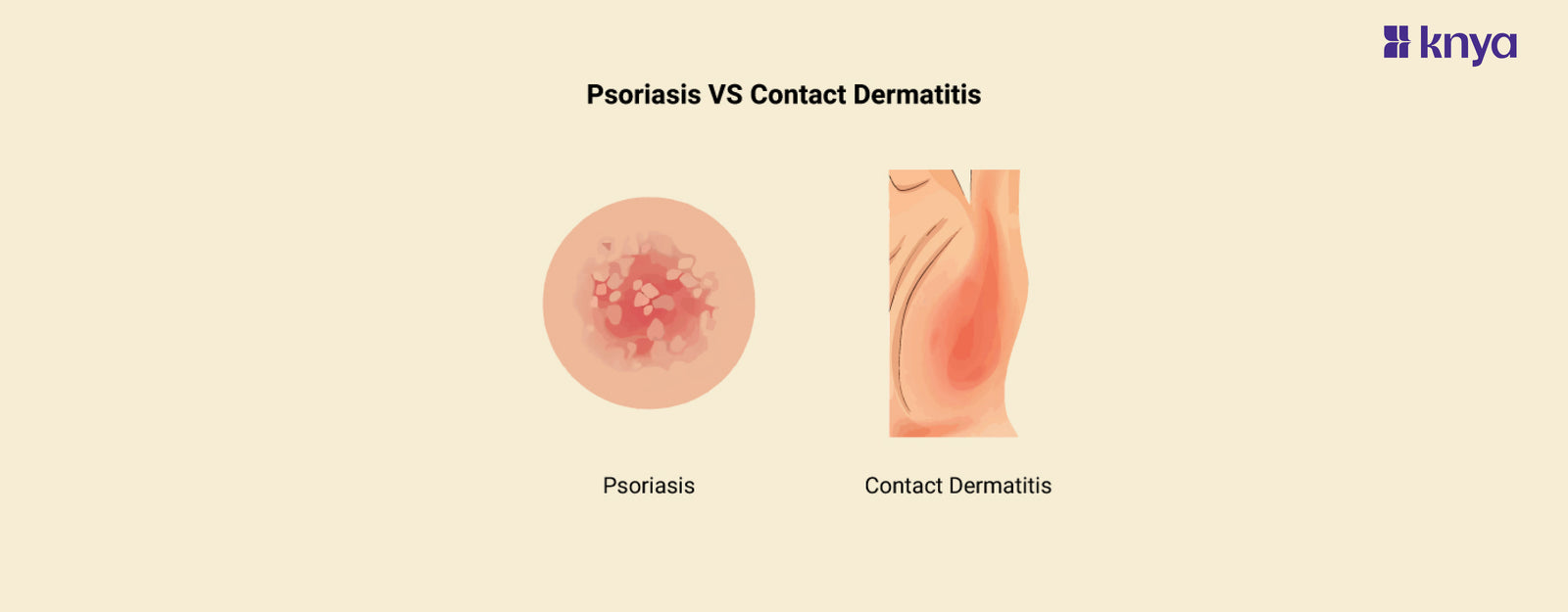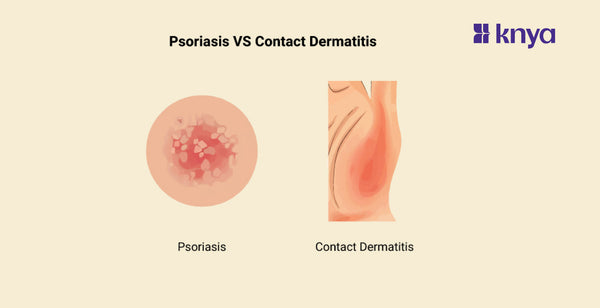Difference between Psoriasis vs Contact Dermatitis: Psoriasis is an inflammatory disease characterised by red, scaly patches that are mostly found on the elbows, knees, scalp, and lower back. It is caused by hyperactive immune responses that speed up skin cell regeneration. On the other hand, Contact Dermatitis happens when the skin encounters any irritant therefore leading to irritation. While Psoriasis is managed with treatments aimed at controlling the immune response, such as topical medications or light therapy, Contact Dermatitis is mainly treated by identifying and avoiding triggers and using topical corticosteroids or antihistamines to alleviate symptoms.
Difference between Psoriasis and Contact Dermatitis
Psoriasis is an inflammatory skin condition that causes red, scaly patches that must be managed to control inflammation and skin cell growth. Contact Dermatitis is caused by direct exposure to allergens. The table below provides the differences between Psoriasis and Contact Dermatitis.
|
Aspect |
Psoriasis |
Contact Dermatitis |
|
Underlying Cause |
Autoimmune disorder; immune system dysfunction |
Exposure to irritants/allergens; immune response |
|
Symptoms |
Raised, red patches with silvery scales (plaques); itching, pain |
Redness, itching, blistering; rash where skin contacts allergen/irritant |
|
Appearance |
Well-defined, raised plaques; silvery scales |
Red, inflamed patches; blisters; may vary in appearance |
|
Chronicity |
Chronic condition with flare-ups and remission |
Can be acute or chronic; resolves with avoidance |
|
Triggers |
Stress, infections, medications, weather changes |
Chemicals, metals (e.g., nickel), plants, cosmetics |
|
Treatment |
Topical treatments, phototherapy, oral medications, biologic therapies |
Avoidance of triggers, topical corticosteroids, antihistamines, oral medications |
Browse The Best Scrubs Collection!
What is Psoriasis?
Psoriasis is a long-term, autoimmune skin disorder marked by a fast accumulation of skin cells that cause red, thick areas covered in silvery scales. Although these so-called plaques can appear anywhere on the body, the elbows, knees, scalp, lower back, and genitalia are the most often affected areas. Although the precise origin of Psoriasis is unknown, immune system, environmental, and genetic factors are thought to be involved. Psoriasis can lead to dry, cracked skin, itching, and discomfort. In certain instances, it can also impact the nails and joints, resulting in changes to the nails and pain in the joints.
Causes of Psoriasis
- Skin Trauma or Injury: Cuts, scratches, and sunburns are examples of areas where Psoriasis lesions might occasionally appear. The Koebner reaction is the name given to this phenomenon.
- Illnesses: Psoriasis symptoms have been linked to the development or exacerbation of some illnesses, most notably streptococcal infections. Streptococcal throat infections, in particular, have been linked to guttate Psoriasis, a type of Psoriasis characterised by small, droplet-shaped lesions.
- Stress: It has been shown that psychological stress might make some people's Psoriasis symptoms worse. Psoriasis flare-ups can be brought on by or made worse by stressful life events, continuous stress, or emotional anguish.
- Alcohol and Smoking: It has been determined that drinking too much alcohol and smoking are two possible risk factors for Psoriasis. People who smoke or drink alcohol excessively may be more susceptible to developing Psoriasis or experiencing more severe symptoms.
- Medication: In vulnerable patients, some medications, including lithium, beta-blockers, antimalarial drugs, and nonsteroidal anti-inflammatory drugs (NSAIDs), may cause or exacerbate Psoriasis symptoms.
Symptoms of Psoriasis
- Red Skin Patches: Elevated, inflammatory skin patches are a common symptom of Psoriasis. These patches are usually pink or red, though they can vary in size and shape. They could show up as separate lesions or combine to form bigger plaques.
- Silvery Scales: Due to the fast skin cell turnover, the afflicted skin frequently develops silvery-white scales. These scales are easily detached and can land on clothing or the skin's surface.
- Discomfort: Psoriasis patches have the potential to cause discomfort and irritation due to their itching. In addition to exacerbating symptoms, scratching the afflicted area may result in bleeding or infection.
- Dry and Cracked Skin: Psoriasis can lead to dry, cracked skin that is prone to fissures.
What is Contact Dermatitis?
Contact Dermatitis can be defined as an inflammation that occurs when the skin comes into contact with an allergen which causes redness, itching and swelling on the affected area.
Causes of Contact Dermatitis
- Irritants: Some substances directly damage the skin’s outer layer, leading to inflammation. These include chemicals in household products, extreme temperature or moisture, certain metals and cosmetic products.
- Allergens: Substances that trigger an allergic reaction in susceptible individuals include metals. Latex. Fragrances and certain medications.
- Industrial Exposure: People who work in certain industries or environments are exposed to chemicals, cement and other irritants.
- Pre-existing Skin Conditions: Individuals with pre-existing skin conditions such as eczema or Psoriasis may be more susceptible to developing Contact Dermatitis due to a compromised skin barrier.
- Genetic Factors: Individuals with a history of Contact Dermatitis may have a genetic predisposition to developing Contact Dermatitis, making them more sensitive to certain irritants or allergens.
Symptoms of Contact Dermatitis
- Redness: The affected area of the skin may appear red or flushed.
- Itching: Itching is a common symptom of Contact Dermatitis and can range from mild to severe.
- Swelling: Swelling or inflammation may occur in the affected area, leading to puffiness or a raised appearance.
- Blisters: Small fluid-filled blisters may develop, especially in cases of allergic Contact Dermatitis.
- Dryness: The skin may become dry, cracked, or scaly, particularly in chronic cases or with repeated exposure to irritants.
Shop Best Lab Coats From Here!
Similarities between Psoriasis and Contact Dermatitis
- Skin Inflammation: Both Psoriasis and Contact Dermatitis cause inflammation of the skin, which further causes redness, swelling, and itching in affected areas.
- Itching: Itching is a common symptom of both conditions. The degree of itching can vary depending on the individual and the extent of the condition.
- Appearance of Rashes: Both conditions can cause rashes on the skin. In Psoriasis, the rash often appears as raised, red patches covered with silvery scales, while in Contact Dermatitis, the rash may be red, itchy, and blistered, particularly in areas where the skin has come into contact with an allergen or irritant.
In summary, Contact Dermatitis is on the whole brought about by using direct contact with irritants or allergens. Psoriasis is an autoimmune disease caused due to rapid skin cell growth. Treatment approaches for each condition vary depending on the degree of the case.
Order the Best Jogger Scrub From Here!
| Check out More Articles | |
| Difference Between Cartilage And Bone | |
| Difference Between Endocrine And Exocrine Glands | |
| Difference Between Cell Wall And Cell Membrane | |















